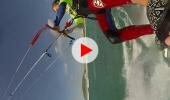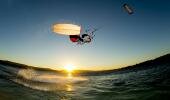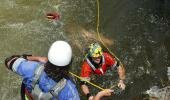Words: Michael Swamer
Kiteboarding is an enticing activity for every board enthusiast out there, with its smooth, fluid motion over the glassy waters of a lake, river, or ocean, and just the wind powering you along. It may seem like a dream, but kiteboarding is not that hard to learn, and once you fly, you're hooked! However, before you rush out and buy any old kite there are a few things you need to take into consideration before letting the wind take you flying. Kiting, like any other extreme sport, can be dangerous if you don’t know the rules and mechanics behind it, but with some basic skills and a gradual introduction, it will become easier over time.
Responsible kiteboarding
Unlike many other sports where you can teach yourself through trial and error, kitesurfing is a sport that requires a number of lessons with a qualified kiteboarding instructor. Not only is this in the best interest of your own safety but also the safety of other kiteboarders and beach goers. The lessons will also help you get accustomed to the equipment and how the kites react in the wind in a safe environment.
The first lesson will usually begin with how to use a trainer kite, which is still powerful, but not powerful enough to lift you off the ground. This will give you a taste of maneuvering a kite and where the power lies. Now when the kite is soaring overhead, there is not much pull, but as you begin to dive and arc it downwards, it’s time to lean back and hang on. This 180-degree arc that the kite flies is called the 'wind window'. To steer the kite, push forward with one hand while pulling back on the other. To dive the kite left pull in with your left hand and out with your right and vice versa.
Next, you will learn about body dragging, which isn’t as painful as it sounds.
Here you practice controlling the kite while your body skims across the top of the water. It feels like body surfing, except instead of a wave powering over the water, it’s the wind and kite. This is useful to know when you lose a board after a fall and it will also further your knowledge of how a kite reacts in the wind, as well as give you a chance to get wet.
Once you feel comfortable with how the kite works, it's time to strap a board to your feet and actually get up and ride. There are numerous ways in which you can start, such as by standing on the shore and jumping, or as you do in wakeboarding, where you start off by lying down and then pulling yourself upwards as you begin to hydroplane. Whatever option you choose for your take off, the kite must be positioned overhead and when you're all ready and have your feet firmly planted on the board, then it's time to arc that kite as you drive your weight through your hips, legs and feet. Once you’re upright, arc the kite again to accelerate and get the board planing.
The next step is learning how to ride back upwind to the place where you started, to avoid the walk of shame back along the beach. To do this, fly the kite low and maintain even power while holding your edge of the board in the water against the kite, then lean back, and swivel your hips and upper body in the direction you want to take, or turn 180 degrees to ride back in the opposite direction. Remember to push your back foot down, to avoid your board slipping out from underneath you, and always look over your should and face the direction where you want to end up.
Once you've completed your kitesurfing course and decided that this sport is definitely for you, it is time to invest in some kitesurfing equipment. You will need the following basic start-up equipment.
Kite
Although there are a number of styles of riding, simplicity is key in the beginning. The type of kite you should look for is one with easy-to-use safety systems, smooth efficient depower, and effortless relaunch. The kite should also have Supported Leading Edge (SLE), also known as bridled, hybrid or Flat-5 kites, as they offer safety and versatility. Pay attention to the wind speeds you expect to fly in and the size of the kites.
When learning, do not expect to ride into powerful winds, as it is more difficult to handle, this will also help keep cost down by owning only a single kite to start off with. I would recommend Freeride gear as one of the best options to start with, as the set-up is forgiving enough that if you make a mistake, it won’t send you flying. Avoid Freestyle and Big Air gear until you are more confident.
Board
As for the boards, it is important to find a board with a comfortable rocker and forgiving flex points that smooth the ride in variable conditions. Narrower boards with larger fins will give you more traction as you glide across the water, as well as slice the water better, thus making chop a bit easier to manage.
Harness
Finding a comfortable harness will make or break a long session out on the water. It is important to find a harness that fits ergonomically and evenly distributes the power of the kite. It is important not to go for a cheap harness because this piece of equipment is essential. There are two types of harnesses; the waist and the seat but the majority of kiting enthusiasts prefer the waist harness. Companies such as Dakine and Mystic offer a variety of harnesses that range in stiffness. For entry level, find one that fits comfortably and is relatively stiff to avoid lower back pain after long sessions out on the water. On the other hand the softer harnesses are more geared towards freestyle progression as it allows for more flexibility in the abdomen.
The life of a harness will outlast that of a kite, but one thing to keep in mind is the harness will become softer over each season of using it. If you start noticing your back being sore with an old harness it is probably time to upgrade. Each company offers a variety of sizes that range according to your waist, so it is important to try them on and find the one that fits most comfortably before buying one. Remember you truly get what you pay for, and this piece of equipment will be used for ALL of your kiteboarding no matter the conditions.
Although it seems like a lot of information to take in, it is good to have some background before going into a lesson, so that you know what to expect, and can see and feel the differences in gear and wind conditions before buying your own. Signing up for a few lessons is advisable, to get completely comfortable with the gear while having an instructor professionally correct your mistakes. It is an exhilarating sport and well worth the upfront cost to get going. Nothing beats the feeling of that kite pulling you as you glide swiftly across the surface of the water, while enjoying the beauty of the surrounding environment.
dinFO
Important tips to remember
In the beginning kiteboarding will be frustrating and will have constant learning curves, but it gets easier over time and the thrill outweighs the time it takes to learn. Lessons will also help to speed up your progression and understanding of the ins-and-outs of equipment, wind conditions, and eventually speed and tricks. What is extremely useful is if you already have riding experience in any number of other board sports. It is important to keep in mind not to go with the cheap options with your equipment, but also not to choose the most expensive equipment either as this will impact your experience of the sport and the life of each piece of your set-up.


